by Tom Gaylord
Writing as B.B. Pelletier

Second-generation Benjamin Marauder in a synthetic stock.
Part 1
Part 2
Part 3
Part 4
Part 5
This report covers:
- What we are testing today
- Trigger adjustment
- Synthetic stock
- Now to shoot
- Other pellets
- Back to the Kings
- Conclusions
It’s been a couple months since we looked at the .25-caliber gen 2 Benjamin Marauder. In that time I have done some things to it. I haven’t reported any of this, but here is a quick rundown of what I’ve done.
The past 2 times I’ve had the rifle out to the range I was getting just 8 good shots (one magazine) on a fill, followed by a second 8 shots that opened up. The second 8 shots were not terrible, they just weren’t as tight as the first 8. And that happened every time.
In Part 4 I adjusted the velocity and ended with what I thought was a 2500 psi fill limit. But it didn’t help things. So, I tried filling the rifle to 3000 psi, but it also did not change the outcome. The second group still opened up more than the first.
I had two rather disappointing sessions at the range in the past 2 months with no good results to report. It was time to make some changes and hope for the best.
What we are testing today
In today’s report I am still trying to get at least 2 good magazines or 16 shots from a fill. The rifle ought to be able to do that at least. It may not get more stable shots than that because a .25 caliber rifle does use a lot of air. But 16 shots would be nice. I keep saying 16 shots because the magazine holds 8 pellets. There might be 18 shots or even 21 good shots per fill, but it’s far more convenient to limit the number to complete magazines.
Trigger adjustment
Before I get to today’s test, though, I was never entirely happy with the way the trigger was adjusted. So I took the rifle out of the RAI modular stock to look at the inside of the trigger assembly more closely. There is a plate on the right side of the trigger assembly that comes off by removing 4 screws. The pins will hold the trigger parts in place, if you don’t jostle the rifle too much.
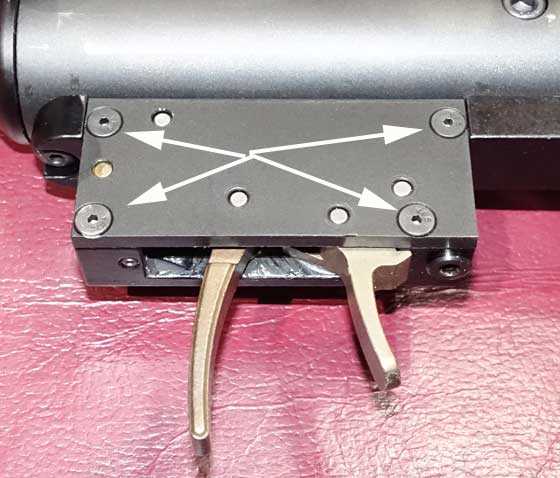
Remove these 4 screws and the sideplate of the trigger assembly comes off. The pins will hold the parts in place if you don’t jostle the rifle too much.
One the plate is removed, you can see which screws do the adjusting. This is where I discovered that the instructions in the owner’s manual can be misleading. It’s not that they are incorrect — they just don’t inform you of how much adjustment needs to be made to each screw. Seeing the parts as you adjust makes the job go much better.
I was able to carefully cock the gun and test the trigger as I watched the parts interact. By seeing the relationship of the adjustment screws and how they affected the parts, I was able to adjust stage 1 to the length I wanted and stage 2 to a very crisp release with no discernible movement.
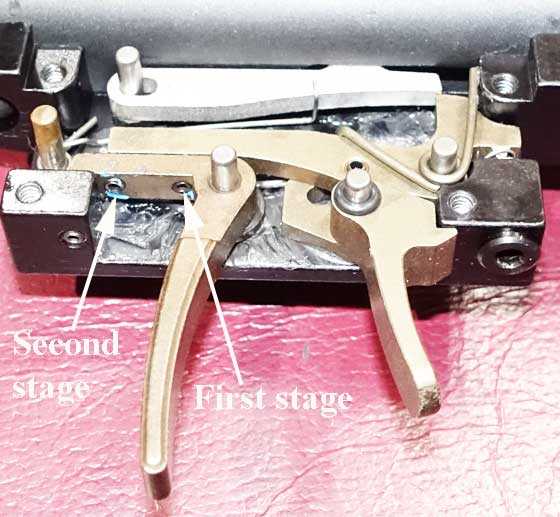
Seeing the adjustment screws, I was better able to adjust them to get exactly what I wanted.
The trigger is now perfectly crisp and releases the same as a Gen 1 Marauder trigger does. The trigger is now set to break at 1 lb. 3 oz. I think this may make the rifle easier to shoot accurately.
Synthetic stock
When I had the rifle out of the stock, I spotted something in the original synthetic stock that was curious. There is a thick rubber pad in the forearm that cradles the air reservoir. The RAI stock doesn’t have a rubber pad. I wondered whether this pad was somehow damping some vibration that might be affecting the second string of 8 shots after a fill. While that’s a stretch, I decided to install the rifle back in the factory stock for today’s accuracy test.

That thick rubber pad (arrow) dampens vibration of the reservoir. It looks like it will fit into any of 4 compartments in the forearm.
With the factory stock back on I decided to shoot the rifle off a sandbag instead of the UTG rubber armored folding metal bipod that was on the RAI stock. This also changed the vibration patterns from the previous tests.
Now to shoot
Now it was time to shoot. I filled the gun to 3000 psi and shot the first group with JSB Exact Kings that have proven to be the best pellets for this rifle. The first group went right to the point of aim and 8 pellets grouped in 0.721-inches at 50 yards. So far, so good.

Eight JSB Exact Kings went into 0.721-inches at 50 yards. A good start.
Now the second magazine was loaded. This would be the real test. This time 8 pellets went into 0.794-inches. This is the first time that the second magazine of 8 from this rifle has grouped as good as the first. Hopefully it wasn’t a fluke.
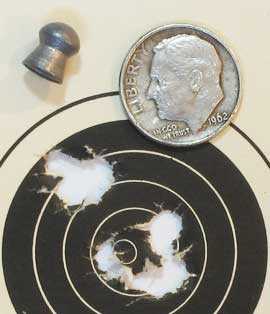
Eight JSB Exact Kings from magazine two went into 0.794-inches at 50 yards. This is what I was hoping for.
Other pellets
Now that I knew the gun could shoot 16 good shots, I checked out 2 other pellets to see what they could do. On the first magazine after a fill I tried 8 of the new 33.95-grain JSB Exact King Heavy pellets. They made a group that measures 1.477-inches between centers at 50 yards. Obviously this isn’t a good pellet for the new Marauder. I will test it in the .25-caliber AirForce Escape, where the increased power may improve things.
Notice that these pellets struck the target almost 1.75-inches lower than the lighter Kings. But they are still in line with the center of the bull.
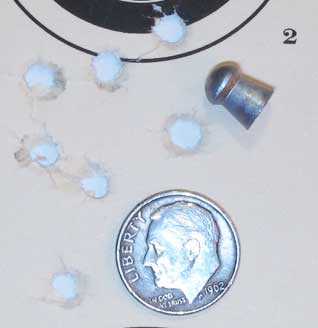
Eight JSB Exact Kings Heavys went into 1.477-inches at 50 yards. Not a pellet for this rifle.
I also tried the .25-caliber Benjamin domes that have no brand name on the second 8 shots after the fill. They landed in a group measuring 1.399-inches between centers. Seven of them are in 0.652-inches, though, so this may still be a worthy pellet to consider. And no, the last shot wasn’t the one that dropped low.
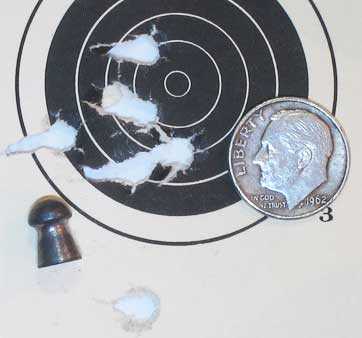
Eight Benjamin domes went into 1.399-inches at 50 yards. Seven of them are in 0.652-inches, making this pellet a contender. Their point of impact is ever-so-slightly lower than the lighter JSB Kings.
Back to the Kings
I wasn’t finished quite yet. Could the rifle return to the Kings and do it again? Could it shoot another 16 pellets to the same point of impact with good groups? I filled the gun and loaded a magazine with the Kings.
The first 8 pellets went to the same aim point at 50 yards and grouped in 0.728-inches. This was good.

Eight JSB Kings went into 0.728-inches at 50 yards. The impact point has not changed. This is good.
The second group of 8 went into 0.903-inches. It was the largest group with this pellet on this day. And the point of impact was in the same place.

The largest group of 8 JSB Kings went into 0.903-inches at 50 yards. The impact point has not changed. If this is the worst the Marauder does, I’d say it’s accurate!
Conclusions
I have to make a number of conclusions from today’s test. First, I like the way the trigger is set. No doubt it is helping me hold on target as tightly as possible.
Next, the 3000 psi fill seems to work perfectly. So even though the chronograph said I should fill to 2500 psi, the 50-yard target tells a different story.
Finally, there may be something to the rubber pad inside the factory synthetic stock. I won’t know that for sure until I re-mount the RAI modular stock and run the same test. That’s planned for next time.
The bottom line is the new second generation .25-caliber Benjamin Marauder is just as accurate as the first generation was. I have played with the gun and uncovered some of its secrets, and now I know what it can do. From here on, everything will be measured against today’s results.

But serious airgunners NEED a chronograph, right :). Seriously, the .25 cal. Marauder is the first PCP that has had much appeal to me. Your current results are looking promising!
BB
Up above where you list what this report covers you say striker adjustment 1 then striker adjustment 2.
I don’t see that covered in today’s report unless I’m over looking it.
And I’m positive the foam works in the stock. I have done that in other pcp guns.
Also I’m glad you mentioned that your chrony results didn’t quite add up to what your shooting results did.
And I have something to ask. Have you considered trying the new Air Venturi single shot trays in your .25 caliber Marauder. I had one of the original Crosman single shot trays and that went to Buldawg for his gun. So I got one of the Air Venturi single shot trays because Crosman does not offer one in .25 caliber anymore.
All I can say is good results with mine. So maybe you can try one out to see how you like them and plus wring out a little more accuracy in your .25 Marauder.
B.B.,
Nice shooting at 50 yds. ! The picture with the rubber pad in the forearm is missing the arrow, but it is quite obvious in the picture. The trigger insides were cool. The large black screw at the bottom right looks like it would be the pull weight screw, but does not look to be the adjustable type. I would suppose that you put some moly lube in all the key places while you had it opened up?
On the second group shown, you have 2 large “1 holers”, essentially 2 groups. I have this happen fairly frequently and have wondered if it was me,..(slight variations in hold, rest, hand placement, etc. from shot to shot),…or,…the rifle? Just curious as to your thoughts when you see a group like that. I figure it is me, doing the same thing, the exact same way, except,.. that I am doing them 2 slightly different ways, but thought I would ask.
Thanks, Chris
Chris,
I fixed the picture of the rubber pad. Thanks.
As far as the 2-hole groups go, I don’t know what causes them, but I do see them from time to time. It must be the hold, though I haven’t figured it out yet.
B.B.
When I was researching my QB-88 the 2 distinct groups from it were attributed to it’s leather seal by one author who said retrofitting with synthetic improved performance, bu stabilizing velocity.Perhaps a regulator IS in order
Reb,
Not sure how to work in a regulator on a springer(s). I am going to say it is me and hold pressures at various points on the rifle. While the TX and LGU are supposed to be (not so much) hold sensitive, I think they are, even if to a lesser degree than most springers.
See some comments below on my responses to some other’s responses. When you can shoot that good and still end up with 2 distinct groups,….you know you are starting to “split hairs” on the VERY fine points of hold and technique.
As for any mistakes,…you do really well for the volume you write. I can type a short post and read and re-read it several times and even spell check and let it sit there for awhile,…..and still,…I will mess up.
And,…without fail,…it is always (after) I hit the “post comment” button,…and there is that brief second or two before it goes through,….THEN I will see a mistake! 😉 Oh, well……
Chris,
When I had my Gamo CFX I would frequently have “two hole” groups. I eventually discovered that the slightest difference in pressure of my thumb of my trigger hand would cause the pellets to go to the right or left group. I could actually alternate between the groups with each shot once I figured it out. Talk about hold sensitive.
RR,
That’s the first positive information I’ve heard about the 2-hole group. My shooting buddy, Otho, gets them with his firearms all the time. I will have to experiment with your idea.
B.B.
RR,
Thanks,…I am going to go with that too. And yes,…I have had the alternating experience as well,…except I can not say that I can control it, like you figured out,… it just happened. I will pay more attention in the future.
Chris:
Large “1 holers” can be explained (I say CAN) by minor differences in weight and size. The farther the distance you shoot, the more un-uniform pellets will cause flyers. If you want to eliminate stray shots, you have to weigh and measure the pellets. And if your rifle likes H&N pellets, then you also need to wash them.
Dutchjozef,
Thanks,…..I figure that plays in as well. Takes time though. Like you,…if I were super serious,..I would do it without hesitation. I have weighed and sorted some. I do not think my steady was good enough to show the better results of the sorted batches.
I have been looking for Jim M. to post some more of his sorting results along with some actual shooting and group sizes.
I believe that the more you eliminate/control other variables,…the more it will come down to me and my skills…..or lack there of,….. 😉
Chris — I’m still around. I’ve been so busy the past couple of weeks I haven’t had time to get much done. I’ve barely sorted any pellets — and I got a new delivery of some last week. I’m hoping to get some range time soon. Still haven’t had a chance to get outside. There’s an indoor 25 yd range I belong to, that’s only about 20 minutes away — but when you add an hour of so shooting time onto 35 – 40 mins round trip travel…….
I’ll get there soon. Have a good weekend.
Jim M.
Jim M.,
Thanks for the reply. 25yds. indoors is ideal for testing. No wind and controlled environment. That would be better than outdoors where lighting and wind can vary.
You are one of the few that weigh and head sort,..(that post their results),…so your work is appreciated. Looking forward to hearing more. Chris
BB,
Thanks for picking this one back up. I have been giving one of these some serious consideration. I even tried to work out a deal for one at the show.
I see that Gamo has brought the CFX back, but they have apparently boosted the power. Perhaps you can persuade Josh Unger to send you an ACCU in .22 to try out. I just put one on my wish list. 😉
B.B.
I am not a PCP guy. However, this report is as interesting as your others.
Could you have inserted the rubber pad in the RAI stock? Who would think that a $.50 piece of rubber would make that much of a difference. Is it a little like bedding a stock?
Thanks,
-Y
Yogi,
The rubber pad is a lot like bedding a stock.
The RAI stock has one long channel instead of 4 compartments. I don’t know if the pad will fit into them, but I will investigate that next time.
B.B.
Sounds like it may just slide back and forth in the stock until it’s optimal location is determined? If so it should actually offer more adjustability than the original’s 4 rigid compartments.
B.B.,
There is a product manufactured by 3M which is a self fusing (no adhesive) silicone electrical tape, it comes in a 30′ roll 1″ wide X .0125″ thick measured with dial calipers and is very pliable. It is called Scotch number 70 high temperature self-fusing electrical tape. I believe that this would be an ideal medium for your purpose. It is pretty expensive to buy from a store but there are many good buys for it on e-bay.
Bugbuster
BB,
What is my purpose?
B.B.
Well,to enlighten us all to the joys and pitfalls of airgunning. 🙂
B.B.,
To use the tape in lieu of the rubber pad in the factory stock when you replace the RAI stock since in all likely hood the factory pad will be too thick. Sorry for the suggestion.
Bugbuster
BB,
Okay, I didn’t understand what you were suggesting. I thought you meant that I should tape the rubber pad in the the channel because it doesn’t have compartments.
B.B.
Bugbuster,
We use some 3M tape at work called 130C or C130,..I can’t remember which. Very sticky and very stretchy. About 1/16″ or 1/8″ thick. Some mastic tapes would be good as well. It would be interesting seeing these types of products applied to a “tune” to limit vibration in key areas…..sort of a “buffer zone” between stock and action if you will.
Chris USA,
I do not believe that sticky would be good in this application since some experimentation will be involved as to placement and thickness. That is the beauty of this particular tape since it only fuses to itself and can be added in .012″ (.3048 mm) increments. That is the thickness given by 3M, mine measured .0005 thicker, split hairs anyone?
There would be another way of doing it using RTV but it would be a more involved process and would require curing time. With the number 70, it is good to go immediately.
The search for ultimate accuracy is a never ending quest.
Bugbuster
Hi B.B.
Interesting blog. A .22 calibre Marauder is on my short list of rifles I would like to own – primarily for its “fiddle value”. Lots of tweaks and mods can be done to it.
Considering the high air consumption of the .25 calibre I think that it would really benefit from a regulator to help manage the fill pressure.
I presume that since you didn’t mention sorting the pellets that you are loading straight from the tin.
From what we have seen from pelletgage sizing and weighing, would it be realistic to say that 20% of the pellets are out-of-tolerance and that of a ten-shot group the two worst pellets should be discounted from the group size measurement?
Hank
Hnk,
Yes, straight from the tin. And yes, sorted pellets would be better. And a third yes — I know that even premium pellets benefit from sorting with a Pelletgage.
I was just so wound up with all the things I was doing that there was no time to add the extra step. I wanted to find out if the rifle had 16 good shots — not what the absolute limit was for accuracy.
B.B.
Too many things you want to do and not enought time to do them all 🙂
I can relate!
Hank
Have you seen theres now jsb premium presorted individually packed weight tolerant to .001 grains pellets?? With jsbs already fronting the pack, could this possibly be worth buying? Maybe competition shooting… might be worth testing, though you probably already have. Im trying to go back in blogs I missed. Its great your testing the mrod and escape, im hoping to take my hunting and target shooting out of the stone age! Though putting trigger springs NOT meant to be dirtbike shocks in the .22 springer im on has given me a better time to start. With the escape being more powerful and if its less finicky then the mrod then escape is numero uno, escape UL would work too, maybe a little quieter without needing a shroud (id rather be loud then have a shroud, just me).
RDNA,
I have a tin of them. Just haven’t gotten to them yet.
B.B.
Ok cool, I can’t imagine jsbs getting much better. I have a question about reticles, cf500? Its made for centerfires from 100 to 500 in 100 yard increments, but in fast dropping .22 or .25 air rifle it has great, simple holdover markers. At 3-9x and 50 yd parallax you can only go to 7 before it blurs in tasco but from 10yds out its clear. If your familiar with this reticle do you know of an AO scope that employs it or similar? It seems perfect for pellets if the parallax was suited for closer range.
Hank,
Interesting concept on going with 8 of 10, (20%). I prefer the “make-up” shot method. I will go (up to) 5 extra on a 10 shot group. By the odds,…the group should get worse, but it will usually work out better for me.
Then,…there are some groups that no amount of extra shots will help! ;( …….;)
Chris,
5 extra shots in a 10-shot group… 50% more – think that this is just an excuse to do more shooting 🙂
You need to know the group size you can expect for a given range but when evaluating accuracy I think that the “core group” is the best indicator of what the rifle can do. How often have we read B.B.s comment “so many in xxx diameter but overall group is yyy diameter”?
I used 20% because I think that that would cover most of the good quality pellets people use. Match pellets would be a lower percentage, economy pellets would be a higher percentage.
Ideally, to determine the true optimum accuracy of a rifle it should be broken in (at least a 1000 pellets), trigger and power-plant tuned, cleaned/lubricated properly, screws tightened and tested in an indoor range with sorted pellets by a skilled marksman who is very familiar with the gun. Ideally – but that rarely can be done when evaluating many rifles.
For a quick review to get an idea of what the rifle is capable of you do your inspection, give the barrel a cleaning, grab a couple of cans of pellets and shoot a bunch of groups at appropriate ranges. Not optimum but gives a good feel for where the rifle is in terms of shoot-ability.
2-cents 🙂
Hank
Nice shooting. Getting 10 shots inside of an inch at 50 yards is remarkable. That is a little disappointing that you can only get two magazines out of one air fill. I go through that number of rounds like nothing.
On the subject of pressure switches for pistols, I’m under the impression that most people just operate the laser or light directly by hand since it is so close. For rifles, the thumb of the shooting hand is the best option I’ve seen yet.
Gunfun1, I’ve seen the fanfare surrounding the release of Savage’s semiauto rimfire in .17 caliber, part of a trend of other .17 rimfire guns, and I must say that I’m a little mystified. In the airgunning world we’ve pretty much established power as a dividing line between airguns and firearms for both .17 and .22. So why get a firearm in an airgun caliber that has more power than .22LR? Perhaps this is to extend the capabilities of varmint shooting. I hear that .17 magnum is very flat-shooting. But don’t lightweight bullets like this get unstable at high velocity? And for more power, why not just get the .22 magnum? The .17 caliber rimfire confuses my paradigm.
Matt61
Matt61
The .17 hmr rounds shoot around 2500 fps with a polymer tip 20 grn. bullet. They have a very flat trajectory and they will hold their own out at 200 yards.
Some people say they shoot prarrie dogs out at 300+ yards with them. I haven’t shot the .22 magnum rounds to be able to compare. But I believe they are around 1800 to 2000 fps with a heavier grn bullet than the .17hmr. So that means it probably won’t have the flat trajectory that the .17 hmr round has. So would take a little more skill to shoot the .22 magnum at different distances. And by skill I mean knowing your holds or clicks for different distances.
And yep another benifit of the the pressure switch on the laser being used with the thumb is helping stabilize the rifle with the thumb pressure. I do believe that I talked with Chris USA in the past about using his thumb at the back of the guns stock to help stabilize the gun. Kind of like what RidgeRunner and them are talking about above.
GF1,
Yes you did mention the thumb behind the safety on the stock with some down pressure applied. It works without a doubt. I will say that if you have any wrist issues, you might notice some difficulty. I am sure I do to some degree, just never confirmed.
Chris USA
That’s funny you say that about wrist issues. I broke my trigger hand wrist when I was kid motocross racing at the local track. I have mentioned that here in the past.
It has actually helped in some ways and hurt in others. If I rotate my wrist forward it will lock in a sense in that position. So of course that helps me steady a gun. But also stocks that have that angled curve where you trigger hand goes makes my wrist hurt. In other words I have to rotate my wrist forward to much. But if I have a stock that has that more straight down pistol type grip it works real well with my wrist the way I can lock it.
BB–I am reminded of the rubber bedding pads that Winchester used in the model 52 C rifle. They stopped using them in the model D. Earlier, late model B stocks had a series of plastic or rubber “bumps” in the stock. I have removed these pads in some of my 52C ,s( the rubber had deteriorated and was useless). There was little or no difference in the accuracy.On the other hand, I have a Rem. 541 HB that does not group as tightly as my 540 or my other 541. Attempts to use plastic and different kinds of sheet rubber did not improve the groups. There are some shooters who have experimented with soft bedding techniques. Perhaps several rubber pads will produce the groups that you seek. Ed
Zimbabweed,
Interesting. That comment relates what Bugbuster and I said above. Even if it does not improve accuracy, it might affect the “feel” of the shot to the better. “Soft bedding” huh” ? Cool !
My “gut” would say that thin is better. Sticky and glue “like” would be better. Too thick and the action would be “sloshing about”.
I will say however,…and I just thought of it,….some mastic tape is like glue for all intensive purposes. Use some really good stuff and I can say with fair certainty that you will never get your action back out of the stock. That would not be a good thing.
Chris–The Winchester rubber pads were very thin. When I took my 52C,s apart they were decades old. The rubber may have been thicker when new. Re using tape, it would probably either adhere to the metal or the stock. A good solvent like goo-gone would remove it if necessary. Ed
B.B. — or anyone else, please chime in.
I am looking for a little help in drafting a message to our state Department of Wildlife. I found out recently a childhood friend is now on the board of commissioners for our state (Kansas). If I draft a letter clearly outlining why KS should allow hunting with air guns, he will work with me to get this in front of the commission for consideration. I’m not an avid hunter — just not enough time — but I would like to see hunting opened up to more than just the currently allowed rabbits, hares, squirrels, and the following:
Amphibians; except bullfrogs;
armadillo;
commensal and other rodents, excluding game and furbearing animals;
feral pigeon;
gopher;
ground squirrel;
invertebrates;
kangaroo rat;
mole;
porcupine;
prairie dog;
reptiles, except common snapping turtles and soft-shelled turtles;
woodchuck; and
wood rat.
Does anyone here have experience in getting their state to open up air gun hunting to deer, maybe turkey, etc? Our neighboring Missouri allows deer hunting with PCP air guns of .40 cal. or larger. If anyone wanted to email me directly about this, please use jemellon66 (at) gmail (dot) com.
Thanks!
Jim M.
I’ve also considered doing this in Texas especially for Turkey but have never written a letter of any professional form and could use help myself.
If you do get it figured out please share what you’ve learned.